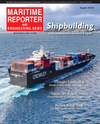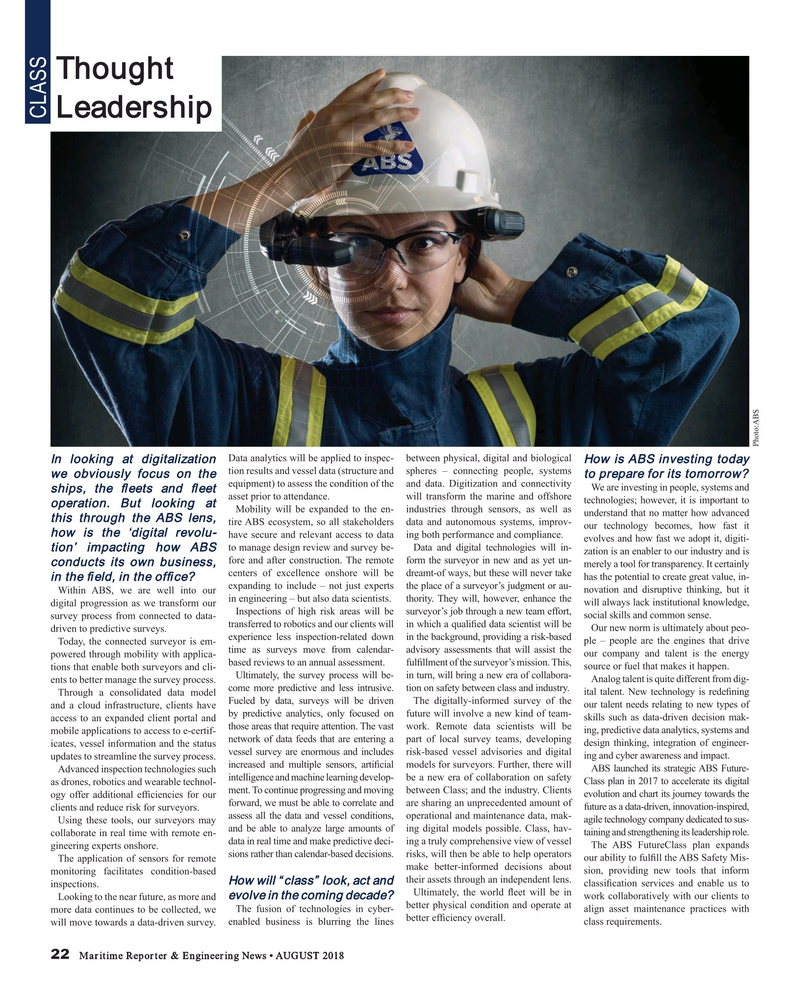
Page 22: of Maritime Reporter Magazine (August 2018)
The Shipyard Edition
Read this page in Pdf, Flash or Html5 edition of August 2018 Maritime Reporter Magazine
Thought
Leadership
CLASS
Photo:ABS
Data analytics will be applied to inspec- between physical, digital and biological
In looking at digitalization How is ABS investing today tion results and vessel data (structure and spheres – connecting people, systems we obviously focus on the to prepare for its tomorrow?
equipment) to assess the condition of the and data. Digitization and connectivity
We are investing in people, systems and ships, the ? eets and ? eet will transform the marine and offshore technologies; however, it is important to asset prior to attendance. operation. But looking at industries through sensors, as well as understand that no matter how advanced
Mobility will be expanded to the en- this through the ABS lens, tire ABS ecosystem, so all stakeholders data and autonomous systems, improv- our technology becomes, how fast it how is the ‘digital revolu- have secure and relevant access to data ing both performance and compliance. evolves and how fast we adopt it, digiti- to manage design review and survey be- Data and digital technologies will in- tion’ impacting how ABS zation is an enabler to our industry and is fore and after construction. The remote form the surveyor in new and as yet un- conducts its own business, merely a tool for transparency. It certainly centers of excellence onshore will be dreamt-of ways, but these will never take has the potential to create great value, in- in the ? eld, in the of? ce?
novation and disruptive thinking, but it
Within ABS, we are well into our expanding to include – not just experts the place of a surveyor’s judgment or au- thority. They will, however, enhance the will always lack institutional knowledge, digital progression as we transform our in engineering – but also data scientists.
Inspections of high risk areas will be surveyor’s job through a new team effort, survey process from connected to data- social skills and common sense.
transferred to robotics and our clients will in which a quali? ed data scientist will be driven to predictive surveys. Our new norm is ultimately about peo- experience less inspection-related down in the background, providing a risk-based
Today, the connected surveyor is em- ple – people are the engines that drive time as surveys move from calendar- powered through mobility with applica- advisory assessments that will assist the our company and talent is the energy based reviews to an annual assessment. ful? llment of the surveyor’s mission. This, tions that enable both surveyors and cli- source or fuel that makes it happen.
Ultimately, the survey process will be- in turn, will bring a new era of collabora- ents to better manage the survey process. Analog talent is quite different from dig- ital talent. New technology is rede? ning
Through a consolidated data model come more predictive and less intrusive. tion on safety between class and industry.
The digitally-informed survey of the our talent needs relating to new types of and a cloud infrastructure, clients have Fueled by data, surveys will be driven skills such as data-driven decision mak- access to an expanded client portal and by predictive analytics, only focused on future will involve a new kind of team- mobile applications to access to e-certif- those areas that require attention. The vast work. Remote data scientists will be ing, predictive data analytics, systems and icates, vessel information and the status network of data feeds that are entering a part of local survey teams, developing design thinking, integration of engineer- updates to streamline the survey process. vessel survey are enormous and includes risk-based vessel advisories and digital ing and cyber awareness and impact.
increased and multiple sensors, arti? cial models for surveyors. Further, there will
Advanced inspection technologies such ABS launched its strategic ABS Future- intelligence and machine learning develop- as drones, robotics and wearable technol- be a new era of collaboration on safety Class plan in 2017 to accelerate its digital between Class; and the industry. Clients evolution and chart its journey towards the ogy offer additional ef? ciencies for our ment. To continue progressing and moving clients and reduce risk for surveyors. forward, we must be able to correlate and are sharing an unprecedented amount of future as a data-driven, innovation-inspired, agile technology company dedicated to sus-
Using these tools, our surveyors may assess all the data and vessel conditions, operational and maintenance data, mak- and be able to analyze large amounts of ing digital models possible. Class, hav- collaborate in real time with remote en- taining and strengthening its leadership role.
data in real time and make predictive deci- ing a truly comprehensive view of vessel gineering experts onshore. The ABS FutureClass plan expands risks, will then be able to help operators our ability to ful? ll the ABS Safety Mis-
The application of sensors for remote sions rather than calendar-based decisions.
monitoring facilitates condition-based make better-informed decisions about sion, providing new tools that inform their assets through an independent lens.
How will “class” look, act and inspections. classi? cation services and enable us to evolve in the coming decade?
Looking to the near future, as more and Ultimately, the world ? eet will be in work collaboratively with our clients to more data continues to be collected, we The fusion of technologies in cyber- better physical condition and operate at align asset maintenance practices with class requirements. will move towards a data-driven survey. enabled business is blurring the lines better ef? ciency overall.
22 Maritime Reporter & Engineering News • AUGUST 2018
MR #8 (18-25).indd 22 MR #8 (18-25).indd 22 8/6/2018 9:38:36 AM8/6/2018 9:38:36 AM

 21
21

 23
23
